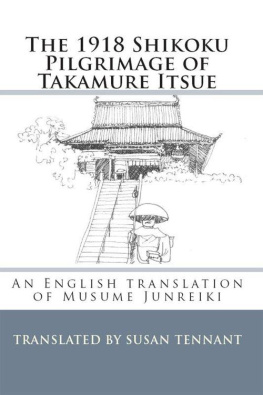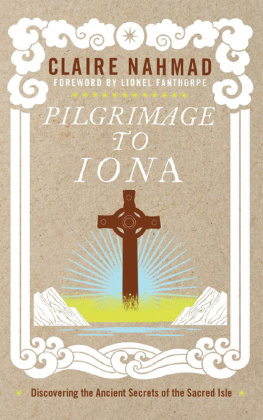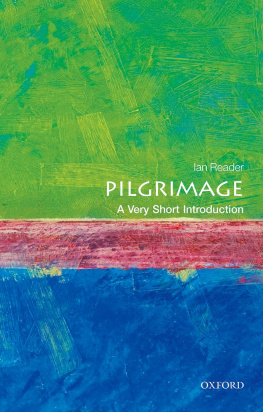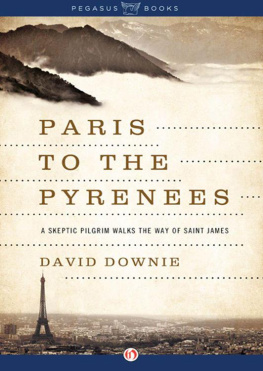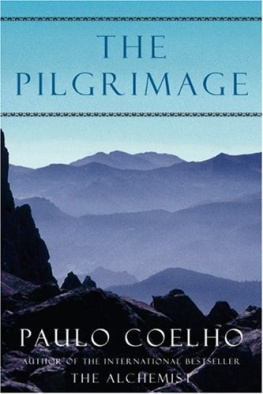
The 1918 Shikoku Pilgrimage of Takamure Itsue: an English translation of Musume Junreiki
translated by Susan Tennant
First edition Copyright 2010 Susan Tennant
All rights reserved. No part of this book may be reproduced or transmitted in any form or by any electronic or mechanical means including photocopying, recording or by any information storage and retrieval system without written permission from the publisher, except for the inclusion of brief quotations in a review.
Temple and vajra drawn by
Bev Greene
ISBN 1450540759
eBook ISBN: 978-1-62111-025-5
Published by
Bowen Publishing
D-101
Bowen Island, BC
Canada VON 1GO
TABLE OF CONTENTS
PREFACE
In the summer of 1918 Takamure Itsue left her home in Kumamoto on the southern island of Kysh, walked most of the way across the island before boarding a train to ita, and then took a ferry to the island of Shikoku. She then walked approximately 1400 kilometres following an ancient 88 temple pilgrimage path. En route, she wrote 105 newspaper articles about her experiences which were published in a Kysh newspaper. Later, in 1979, these articles were published in book form as Musume Junreiki (The pilgrimage journal of a young woman), a book which has since been republished several times.
The book which you have in your hands is an English translation of Musume Junreiki. If reading this translation whets your appetite to learn more about Takamure Itsue and the Shikoku pilgrimage, you will find information about both in the appendices at the end of this volume. Takamures reasons for making the pilgrimage were complicated and her life equally complex.
There is also a glossary of Japanese terms. The first time that a Japanese term is used in the book, its meaning is explained in a footnote but a glossary of terms is provided as well. Readers will also find information about the Shikoku pilgrimage as well as a map of the pilgrimage route.
Japanese custom has been followed throughout in giving the family name first followed by the given name.
May those who read these book be as charmed by Takamure and her experiences as I have been.
ACKNOWLEDGEMENTS
First, I must thank Takamures sister in law, Hashimoto Shizuko, for giving me permission to translate Musume Junreiki. In addition, thanks are due to Horiba Kiyoko, the editor of Musume Junreiki, a Japanese feminist historian well known for her research on Takamure Itsue, who put me in touch with Hashimoto Shizuko.
Musume Junreiki (The pilgrimage journal of a young woman) was difficult to translate. The 105 newspaper articles which comprise the book were written in 1918 using the old Japanese writing system and there are many kanji and expressions in the articles which are no longer used. In addition, Takamure Itsues writing style has many peculiarities.
I could not have translated this book without help from many people, all of whom I wish to thank. The four woman with whom I co-wrote Awa 88: a bilingual guide to the pilgrimage temples in Tokushima Prefecture, Shinohara Nobuko, Kametaka Yoko, Negishi Keiko and Yamada Takako, helped me understand the Shikoku pilgrimage, its history and traditions and its place in the hearts of the Japanese.
Nakamura Masami, of Iwakura, Aichi Prefecture, helped me to read the Japanese text, as did Kakuse Kumiko of Nagoya University. Professors Hamaguchi Keiko and Tsuno Kosuke of the former Tosa Womens Junior College, Prof. Okumura Eiko of Kobe Womens University helped me with the goeika as did some of the priests of the pilgrimage temples and Taniguchi Mysh of Murykin temple on Mount Koya. Prof. David Moreton of Tokushima Bunri University was encouraging and helpful and Prof. Ian Reader of the University of Manchester kindly gave me permission to use his map of the pilgrimage route. Bev Greene provided the drawing of the temple and the vajra.
Professor Eiichi Kageyama (Retired) of Takushoku University generously gave me many hours of his time and assisted me by researching and supplying useful information and by reading and correcting my preliminary translations of Musume Junreiki. This book would not exist without his help.
If there are others whom I have failed to mention, please accept both my thanks and my apologies.
Susan Tennant
Bowen Island, Canada
February 2010
takamureitsu@yahoo.ca
Article 1: BEFORE THE PILGRIMAGE
Even I myself dont know why I resolved to make the pilgrimage, but the following is part of a letter I wrote to Miyazaki Daitar. I will be very pleased if you can understand, even just a bit, the kind of person I am by reading this section of the letter.
Today is the fourteenth of May. These days I am madly addicted to readingmorning, noon, and night, even when drawing water, even when cooking rice. I just have to read. If I dont read, its utterly unbearable.
Please dont ask what the reason is; even I myself dont know. At times I wonder if Ive gone crazy. However, there doesnt seem to be anything particularly the matter. Only, its strange that I easily become extremely emotional and distressed, and that I can cry noisily and copiously.
Also, it is absolutely horrifying how my imagination, limitlessly, endlessly, and boundlessly, extends really grotesque, dark wings. There are times that I have a sharp pain in my heart because I vividly picture the scene of my death.
In the evening, while strolling among the rows and rows of tombstones in the precincts of the old temple where I am temporarily allowed to stay, I often sense something coming suddenly and looming right in front of my eyes. I wonder if this is an image projected by my vague dread of magnificent, mysterious things. When I watch calmly as though I were a spectator and observe myself, I really do see a black shape coming sternly and gravely towards me, about which I can do nothing.
This is actuality. Actuality threatens me because it is actual; the ideal threatens me because it is ideal. In the first place, where does life end and where does death lead?
Going on a pilgrimagethats particularly easy for 1 Names are written Japanese style with the surname first. Miyazaki was then City Editor of the Kysh Nichi Nichi Newspaper and had the pen name of Ktei. me. There is nothing in the world more painful than stagnating. I even think that venturing recklessly into an unknown world has perhaps more significance than that.
(I have omitted the rest. This is the letter that I never sent to Mr. Miyazaki.)
May twenty-fourth. After eating supper I visited the Kannon D and had the pleasure of meeting the resident nun for the first time. She is an extremely gentle and serene person and while talking with her I felt a yearning such as one feels in the midst of a spring breeze. I felt strongly that what was most important was practice rather than theory, and virtue rather than knowledge.
Go on a pilgrimage? That is commendable, but I dont know much about pilgrimages. How about visiting Mr. Yamamoto Sgan in Shinsaiku-machi?
I thanked her, excused myself, and returned home. Then, the next day, the twenty-fifth, I went without delay to Mr. Yamamoto, listened to him talk about various things, and at the same time received careful, kind instruction about pilgrimages, including clothing and what not.
To be honest, at first I was thinking of the Saigoku pilgrimage
Next page
